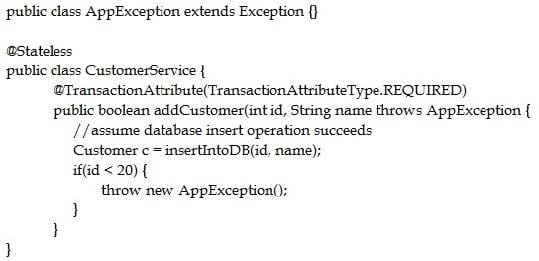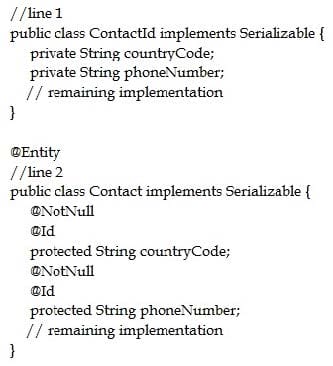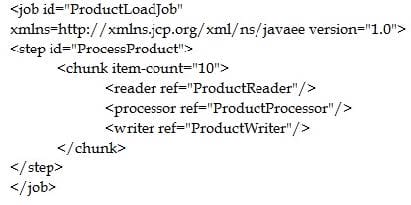1Z0-900 Online Practice Questions and Answers
Given:

If an exception is thrown inside the if block, what effect will it have on the transaction?
A. The transaction will be committed.
B. The transaction will be suspended.
C. The transaction will be rolled back.
When handling a JSF request, your application code decided to redirect the call to another URL by using HTTP redirect. Which action should you take to correctly complete the handling of the JSF life cycle?
A. Set the immediate="true" attribute on the command button that was used to perform this call.
B. Invoke the dispatch() method on the ExternalContext object.
C. Invoke the setCurrentPhaseId(RENDER_RESPONSE) method on the FacesContext object.
D. Invoke the responseComplete() method on the FacesContext object.
Given the code fragments: Which action completes this composite primary key implementation?

A. Add @IdClass annotation at line 1.
B. Add @Embeddable annotation at line 1 and replace both @Id annotations with @EmbeddedId annotations.
C. Add @IdClass(ContactId.class) annotation at line 2.
D. Add @Embeddable annotation at line 1 and @EmbeddedId(ContactId.class) at line 2.
You are working with JMS publish-subscribe operations.
What happens when a producer publishes a message to a topic for which a durable subscription exists but there are no subscribers available?
A. The publisher waits for a subscriber, who then consumes it. However, the publisher will time out if no consumer arrives within the given timeout period.
B. The publisher sends the message. However, it is never consumed because there wasn't anything listening when it arrived, regardless of the message timeout length.
C. The publisher successfully sends a message, which will be consumed later, once there is a subscriber, assuming the message hasn't timed out.
D. The message publisher is immediately notified about the lack of subscribers and can decide for itself if, and when, to resend.
Given a JSL document describing a batch job:

How do you initiate a batch job?
A. Get the JobExecution object from BatchRuntime and call its start() method.
B. Get the JobExecution object from BatchRuntime and set its status to JobStatus.INITIATED.
C. Get the JobOperator object from BatchRuntime and call its start() method.
D. Call BatchRunTime.initialize("ProductLoadJob");
Which statement is true about Java methods that are exposed as Web Service operations by using JAXWS API?
A. The @WebResult annotation must exist.
B. Method parameters and return types must be JAXB compatible.
C. Method parameters must be declared by using @WebParam.
D. The @WebMethod annotation must exist.
Given the JPQL code fragment:
Select pub.title, pub.author, pub.pages FROM Publisher pub
Which two clauses do you add to this JPQL query to retrieve only those books with between 500 and 750 total pages? (Choose two.)
A. WHERE MIN(pages) >= 500 AND MAX(pages) <= 750
B. WHERE pub.pages <= 500 OR pub.pages >= 750
C. WHERE pub.pages BETWEEN 500 AND 750
D. WHERE pub.pages <= 500 AND pub.pages >=750
Your client wants the purchasers to be able to run the min-max for items under their control and then manage the POs created out of these.
Which parameters can they use to be able to do this?
A. Planning Level
B. Sort by
C. From Item to Item
D. From Buyer to Buyer
E. From Planner to Planner
Which action invokes supply chain orchestration and transfer of data to supply chain orchestration Interface tables?
A. creating Purchase Order Receipt
B. running a scheduled process called "Create Transactions"
C. running Min-Max Planning
D. creating a new Inventory Organization for execution of supply chain orchestration
Your company has multiple inventory organizations where goods are transferred internally. A user has created a new organization but new organization is unavailable when creating an interorganization transfer.
What is the missing setup?
A. Inventory organization data access for users is not set up.
B. Interorganization Parameters are not set up between the organizations.
C. The destination organization transfer type is In Transit.
D. The source and destination organization doesn't belong to the same legal entity.
Your customer is a very large organization spanning across multiple countries. Their legal requirements, Human Resource Policies, and Functional Currencies for Ledger are different for each country. Your customer wants to maintain 10 different companies in the system.
Which combination meets this requirement?
A. 1 Enterprise, 10 Divisions, where each division has its own ledger with common legal entity across all divisions
B. 10 Enterprises, 10 Divisions, where each division has its own legal entity and ledger
C. 1 Enterprise, 10 Divisions, where each division has its own legal entity and ledger
D. 10 Enterprises, 1 Division, where each division has 10 legal entities and 1 ledger
Which execution document is created by supply chain orchestration when a make request is received?
A. Transfer Order
B. Work Order
C. Routing Create
D. Movement Request
E. Purchase Order
Your client has decided that Discrete Manufacturing will be implemented at a future stage, so any new supply from current manufacturing will be added to current inventory by the Open Transactions Interface. The immediate requirement is to go live with Inventory and Order Management.
Which two seeded transaction types can be omitted for material status control?
A. All Transaction Types Related to Work in Process
B. Average Cost Update
C. Backflush Subinventory Transfer
D. Miscellaneous Issues and Receipts
E. All Internal Transactions
You set up an item organization and an inventory organization as part of your customer's requirement.
Your customer has, by mistake, performed a receipt transaction in the item organization instead of the inventory organization. How will you rectify this error?
A. Perform a correct receipt transaction and receive the item in the correct organization.
B. Perform a return of item and receive the item again in the correct organization.
C. It is not possible to receive item in the item organization.
D. Perform a new receipt in the correct organization and retain the stock in item organization because it does not affect any other operation.
In Supply Chain Orchestration, Automated Change Management performs which two functions?
A. change to need by dates of a purchase order
B. splitting of a sales order
C. changing the ship method on a sales order
D. change to item attributes
E. changing the supplier on a purchase order
